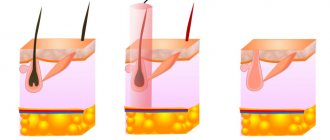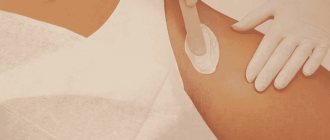What is a laser facial hair removal procedure?
Laser facial hair removal is an innovative depilation technique, the essence of which is the effect of thermal flashes on the hair follicles. Penetrating through the epidermis, the laser beam passes through the entire hair, and when it reaches the bulb, it heats it, as a result of which the follicle is destroyed and falls out. The laser only affects hairs that are in the active growth stage, so several sessions (from 4 to 10) are necessary to completely remove all hair.
After the procedure, hair growth stops for several years, and the newly appeared hair becomes lighter and softer. This procedure is suitable for both women and men.
Comparisons with other removal techniques[edit | edit code]
Electrolysis
Comparison with Intense Pulsed Light (IPL)
In 2006, the journal Lasers in Medical Science published a review article comparing hair removal methods using IPL, alexandrite and diode lasers. The review found no statistical difference in short-term effectiveness (6 months) but a higher incidence of side effects with diode laser. Hair reduction after 6 months was 68.75% for alexandrite laser, 71.71% for diode laser, and 66.96% for IPL. Side effects were reported as 9.5% for the alexandrite laser, 28.9% for the diode laser, and 15.3% for the IPL. All side effects were temporary and even pigmentation returned to normal within 6 months.[10]
The IPL laser, although technically not containing a laser, is sometimes incorrectly referred to as "laser hair removal." ELOS methods, sometimes called "phototricholysis" or "photoepilation", use xenon flash lamps that emit a full spectrum of light. IPL systems typically have wavelengths in the range between 400 nm and 1200 nm. Filters are used to block shorter wavelengths, thereby only using longer, “redder” wavelengths for clinical use. The main advantage of IPL laser hair removal is that it uses a longer light pulse of up to 250 ms, which is beneficial for larger target diameters.[11][12][13]
Comparison with electrolysis
Electrolysis is another hair removal method that has been used for over 135 years.[14] Unlike laser hair removal, electrolysis can be used to remove 100% of visible hair from the treated area and works on hair of all colors if used at the proper power level with the correct technique.
A 2000 study conducted at the ASVAK Laser Center in Ankara, Turkey, comparing alexandrite laser and electrolysis for hair removal on 12 patients concluded that laser hair removal was 60 times faster, less painful and more reliable than electrolysis. Also, the latter requires contact of the current with the hair for 30 seconds to or more than a minute (which is very painful) to release each hair, while light hair removal requires much less time.[15]
Facial hair removal areas
There are the following areas for laser facial hair removal.
Hairline
Sometimes the hairline is too low. Laser hair removal allows you to lift it a little, changing the appearance. A course of depilation of the hairline consists of 4-5 sessions, between which there is a break of 2-3 weeks.
Forehead
A drooping forehead is a common problem that can be corrected with laser hair removal. After the first session, the forehead rises, becomes higher and more open.
The space around and between the eyebrows
The ideal eyebrow shape is every girl's dream. Using laser hair removal, you can eliminate unibrows and give your eyebrows a clear, beautiful shape that will last for many years. The form is selected individually by a cosmetologist.
Cheeks
Constant shaving of cheek hair in men causes severe discomfort and irritation. Laser hair removal removes hair painlessly and safely for a long time.
The so-called sideburns
Removing sideburns allows you to make the contours of the face and hairstyles clearer in men, and makes women more attractive and tender.
Ears
Excision of ear hairs is the simplest and safest procedure, since the amount of hair is small and the skin is less sensitive and almost not prone to irritation.
Nose (surface and mucous membrane)
Nasal depilation is one of the most difficult and unpleasant procedures, since the mucous membrane is too sensitive and the hairs are inaccessible. Laser hair removal allows you to remove nasal hair quickly and almost painlessly.
Upper lip (the notorious mustache)
Mustaches are a common problem among women. They give an unaesthetic appearance and significantly reduce self-esteem. Radical hair removal above the upper lip is performed in 4-5 sessions. The laser is applied from the corner of the mouth to the middle of the lip.
Chin
Laser hair removal of the chin in women allows you to get rid of protruding villi and an unsightly beard. A laser epilator cuts out vegetation quickly, for a long time and without negative consequences.
Neck
Many men and women suffer from low hairline at the back of their heads. Laser hair removal helps to gently eliminate this problem by removing hair from the entire circumference of the neck through non-contact pulsed laser action.
The essence of the technique
The energy of the laser beam hits the root of each hair. It heats up and melts. After a few minutes, the hair shaft disappears completely. Dormant or inactive hair shafts are not affected, so the procedure will have to be repeated several times.
An excellent effect is obtained if you use a laser:
- in intimate areas;
- above the upper lip;
- to remove beard;
- on the arms and legs;
- on the shoulders and buttocks;
- in the décolleté area; in the armpits,
- on the stomach and back.
Special devices not only remove excess hair on the body and face, but also remove spider veins, age spots and broken capillaries. The laser beam is aimed at a specific area where there is excess vegetation.
The eyes of the master and the man are covered with special glasses. The beam affects the skin with short breaks. The entire procedure takes from a few minutes to half an hour.
On the page, read about another way to remove unwanted body hair.
Preparing for the hair removal procedure
Laser hair removal is more of a medical than a cosmetic procedure, so a preparatory stage must follow before it is carried out. How to prepare for laser hair removal on your face? To do this, you must first consult with a specialist and make sure there are no contraindications, and then follow the following recommendations:
- 2 months in advance you need to stop removing hair by any method other than shaving or chemical depilation;
- at the time of hair removal, the length of the hairs should be 3-5 mm, so in 2-3 days you need to remove the hair superficially;
- 2-3 weeks in advance you need to stop sunbathing and visiting the solarium;
- within a couple of weeks you should stop using alcohol-based cosmetics;
- 14 days in advance you must stop taking tetracycline antibiotics and some other drugs;
- Peeling cannot be done later than 3 days before the session.
It is not recommended to do laser hair removal during menstrual periods or in the first week after them, as pain intensifies during this time. You can learn about other necessary preparatory measures during a consultation with a specialist.
For uterine fibroids
Laser hair removal for uterine fibroids is not a categorical contraindication to the procedure. The laser beam is not able to penetrate deep into the human body, its action is limited to the depth of the subcutaneous hair follicles, thus this type of getting rid of unwanted vegetation will not provoke further development or growth of fibroids.
In the capable hands of a qualified cosmetologist working with good equipment, you can easily and almost painlessly get rid of unwanted hair on any part of the body in the absence of contraindications or serious diseases for a long time.
Smooth, velvety skin and the absence of the need to regularly remove growing hairs are worth visiting a good salon several times and undergoing a course of procedures on the desired areas of the body.
A beauty blogger talks about myths about laser hair removal, contraindications and nuances.
How does laser hair removal work on the face?
After all the preparatory activities have been completed, you can proceed directly to depilation. Laser facial hair removal for women is carried out as follows:
- The specialist determines the client’s phototype and, based on the data obtained, sets the appropriate parameters on the equipment.
- If the patient is afraid of pain, then an anesthetic is applied 30-60 minutes before the procedure. The type of pain relief is selected individually in advance. The most commonly used is lidocaine spray or ointment.
- The client is placed comfortably on a couch, face up, and wears special safety glasses to prevent eye damage.
- The master thoroughly cleanses the patient’s skin of cosmetics and dirt using special cosmetics.
- Using a pencil, contour points are placed on the skin to define the depilation area.
- The specialist moves the laser over the designated area, directing the beam at the hairs that need to be removed. This operation is carried out without contact, therefore eliminating the possibility of damage and infection of the skin.
- At the end of the procedure, the remaining anesthetic is removed, and a special soothing and cooling agent is applied.
Laser hair removal on the face usually takes only 10-15 minutes and is accompanied by minimal pain, so there is often no need for pain relief.
How does a laser work?
Laser hair removal is a modern technique in hardware cosmetology, the purpose of which is to remove hairs growing in the wrong place. Mustaches and beards are the domain of men, but for women, the skin above the upper lip and chin should be smooth - this is what the procedure promises.
A laser beam is used as a weapon, which has an excellent effect even on areas with sensitive skin. It is directed to the area where the hair follicles (bulbs) are located. The laser acts on the part where melanin is contained - the pigment responsible for hair color; it absorbs light radiation and generates heat, which has a destructive effect on the hair follicle, without affecting the surrounding skin.
After a short period, the hole remaining in the place of the follicle tightens and the skin becomes smooth.
You may also be interested in learning about which hair removal is the most effective and how to do it.
Positive and negative sides
Like other cosmetic procedures, laser hair removal of the upper lip has both advantages and disadvantages.
And it is better to inquire about them in advance. The advantages include the following:
- The laser acts gently, without causing pain to the patient. This effect is due to the presence of a cooling system that prevents the skin from getting damaged.
- Laser hair removal does not change or have a negative effect on the structure of the skin.
- After the procedure, there are no noticeable defects left on the skin . Naturally, when removing a mustache, a woman would not want to get scars, rashes and other unpleasant things instead.
- The method gives very high results. Most patients who undergo the procedure manage to completely get rid of unnecessary hair. Statistics indicate an encouraging figure of around 93%.
- While most types of hair removal are not recommended during the warm season, laser hair removal can be performed year-round.
But how many days after laser hair removal does hair fall out and which type is the best is indicated here.
In the video, how laser hair removal of the upper lip occurs:
But in every ointment there is a fly in the ointment, and the disadvantages are as follows:
- There is a possibility of complications - in patients with a weakened immune system (usually this occurs against the background of infectious diseases), these diseases may worsen.
- There is a risk of burns - such skin injury can occur if the procedure is performed on faulty, outdated equipment or due to the unprofessionalism of the technician.
- Visual impairment resulting from laser beams entering the eyes. This can happen if the safety glasses do not fit well or if the client refuses to use them.
- Increased skin pigmentation (hyperpigmentation).
But how to choose the right cream after hair removal and which is the best is indicated here.
Manifestation of an allergic reaction
Development of the inflammatory process in the follicles (folliculitis). This disease can develop due to increased sweating of the patient.
It does not work on all hair - the technique has an effect only on fair-skinned people, whose hair shade varies from light brown to black.
When considering laser hair removal as a way to get rid of hairs above the upper lip, it is worth evaluating the pros and cons, especially since the method is quite expensive, and in most cases the procedure has to be carried out more than once.
You may also be interested in information about how laser bikini hair removal is done.
When is hair removal indicated and when is it contraindicated?
Laser hair removal of mustache is recommended if:
- dark hairs grow above the upper lip;
- there is a tendency to ingrown hairs;
- other methods of getting rid of unwanted hair lead to allergies or irritation (for example, using wax strips, depilatory cream, etc.).
But hair removal will please you with the expected result if you take it seriously and familiarize yourself with the available contraindications:
- The laser should not be used on critical days - during menstrual bleeding in women, the pain threshold decreases, and there is a risk of swelling and hematomas in the area affected by the laser beam.
- In diabetes mellitus, this is associated with increased pain and vulnerability of the skin to various pathogens, which is extremely undesirable for this disease.
- For inflammation of the tissues of the upper lip caused by a fungus, bacteria or other pathogen.
- Pregnant women and nursing mothers should not attend such procedures.
- If there are birthmarks, warty nodules, pigmentation and other formations in the antennae area.
- For oncological diseases.
- For acute inflammatory diseases of the respiratory system caused by viruses.
- If the patient has tanned skin or it is a natural dark pigment.
- In case of exacerbation of diseases caused by viruses or infections.
- If there is a hormone imbalance.
- If in the mustache area the hairs have red, light pigment or do not contain it at all, that is, they are gray.
- Injury to the skin in the area of intended treatment. Abrasion, cut, ulceration - any damage is a contraindication.
- Impaired skin cell regeneration.
- Blood diseases that are accompanied by frequent bleeding and poor clotting.
- When taking certain medications at the same time.
Before a laser treatment session on the upper lip, it is recommended to visit a therapist and undergo several tests to find out if there are any contraindications.
It will also be interesting to know how hair grows after laser hair removal.
Features of male facial hair removal
Laser hair removal is very popular among men. With its help it is possible to eliminate the following problems:
- skin damage and irritation after frequent shaving;
- prickly, hard stubble;
- ingrown hairs;
- unsightly hairline;
- hyperhidrosis.
The process of laser hair removal of the chin and cheeks for men is carried out in the same order as for women, however, due to the increased rigidity of the hair, about 10-12 sessions will be required to achieve the desired result. The duration of the result is only 2-3 years, after which the course must be taken again.
Possible complications
Laser hair removal is a relatively safe procedure. However, if contraindications and specialist recommendations are neglected, the following unpleasant consequences may be observed after depilation:
- burns;
- subcutaneous bruising;
- hyperpigmentation;
- scarring;
- folliculitis.
Laser hair removal can provoke an exacerbation of chronic diseases and cause endocrine disorders and increased hair growth. If safety precautions are neglected, visual damage may occur. You can avoid such complications if you follow all the specialist’s recommendations and choose a good, experienced specialist.
For psoriasis
Laser hair removal for psoriasis is possible if a highly qualified cosmetologist takes an individual approach to the patient’s problem and chooses a gentle laser power to destroy the hair follicle in the treated area of skin.
Before the procedure, it is better to visit your doctor to discuss the likelihood of disease progression, enlargement of the area with psoriatic plaques, or hyperpigmentation.
Did you know?
To remove unwanted hair, you need to conduct approximately 5-7 sessions with a certain interval between them.
Contraindications
It is prohibited to perform facial hair removal with laser if you have the following diseases:
- diabetes;
- phlebeurysm;
- infectious pathologies;
- herpes;
- oncological processes;
- inflammatory processes;
- dermatological diseases;
- ARVI, cold.
You should refrain from laser hair removal if there are any lesions on the skin, pigment spots, moles or benign neoplasms. It is strictly forbidden to carry out the procedure during pregnancy, as pain can provoke an increase in the tone of the uterus and seriously harm the baby. During lactation, such manipulations should also be avoided. This method of depilation can only be performed from 18 years of age.
Laser parameters that affect the results[edit | edit code]
Several wavelengths of laser energy have been used for hair removal, from visible light to near-infrared radiation. Lasers are characterized by their wavelength, measured in nanometers (nm).
| Argon: 488 nm (turquoise/blue) or 514.5 nm (green) (no longer used for hair removal) |
| Ruby: 694.3 nm (deep red) (safe only for patients with very pale skin) |
| Alexandrite: 755 nm (closer to infrared) (safe and effective for all skin types, Fitzpatrick types I-VI) |
| Pulsed Diode: 810 nm (near infrared) (pale to medium skin types) |
| Nd:YAG : 1064 nm (near IR) (to treat darker skin types, although effective on all skin types) |
| Intense Pulsed Light (IPL is not a laser) 650nm wavelength light (used for hair removal on pale to medium skin types) |
Pulse Width (or Duration)
is one of the most important parameters. The length of the thermal impulses is directly related to the damage occurring in the follicle. When trying to destroy hair follicles, the main target is the germ cells that live on the surface of the hair. Light energy is absorbed by the melanin of the hair and heat is released. The heat then leads towards the germ or stem cells. A sufficiently high temperature is maintained for the required time, then the cells will be successfully destroyed. This is certainly important, since not only the temperature of the beam is important, but also the time that this beam is “stored” in the follicle, affecting the germ cells.[16] To achieve these conditions, the laser/IPL system must be capable of generating the required output power. The main reason why hair removal fails is because the equipment cannot create the right temperature in the right amount of time.
spot size
, or the width of the laser beam, directly affects the penetration depth of light energy due to scattering effects in the dermal layer. Larger beam diameters conduct deeper energy deposition and can therefore induce higher temperatures in deeper follicles. The laser beam has a diameter comparable to the tip of a finger (3-18 mm).
Fluence or energy density
- This is another important parameter. Fluence is measured in joules per square centimeter (J/cm). It is important to adjust this parameter so that the temperature inside the follicle is sufficient to destroy the hair stem cells.
Epidermal cooling
allows you to work at higher fluences and reduce pain and side effects, especially on dark skin. 3 types of epidermal cooling have been developed:
- Contact cooling: special tool with a cooling tip. In such instruments, laser radiation is directed through a sapphire window in contact with the skin. The sapphire window, which has a high thermal conductivity, is constantly cooled using a built-in thermoelectric converter or by pumping refrigerant. A nanotech sapphire window with contact cooling of the working laser emitter before, during, and after the procedure allows for painless hair removal. Sapphire windows are much more conductive than quartz. This type of cooling is the most effective method of maintaining epidermal protection as it provides continuous heat transfer to the surface of the skin.
- Cryogen spray: sprayed directly onto the skin immediately before and/or after the laser pulse
- Air cooling: directed flow of cold air at -34 degrees C.
In essence, an important output parameter in hair removal (and other skin conditions) is power density - a combination of energy, spot diameter and pulse duration. These three parameters determine what actually happens when a beam of light is absorbed by a chromophore, be it melatonin, hemoglobin, etc. the volume of tissue destroyed depends on exposure time and temperature.
Facial care after the procedure
To avoid negative consequences after laser hair removal of the face, it is necessary to provide the skin with proper care. To do this, follow the following recommendations:
- for the first day, do not allow water to come into contact with the depilated area of the skin;
- for 3 days, refuse a hot bath and any thermal procedures;
- For several days after depilation, refrain from using alcohol cosmetics;
- Sunbathing is prohibited for 14 days; sunscreen must be applied to the skin before going out in the sun;
- Do not have an aggressive effect on the skin (peeling, massage).
In the intervals between sessions, you cannot use other methods of depilation. If the hairs have grown a lot, then they can be trimmed a little. If severe irritation or complications occur, you should consult a doctor to select medications.
Precautionary measures
Cosmetologists recommend performing a skin test of wax depilatory products on a small area of the body before applying wax to large areas of skin. Usually the test is done on the wrist, the inner surface of the elbow. The result of “mini-depilation” is observed within 24 hours. If there is no redness, rash, irritation, or itching after 24 hours, you can safely get down to business.
You should follow the necessary skin care requirements after the wax procedure:
- scrub regularly (but not on the day of hair removal);
- effectively cleanse the skin;
- use skin care products (moisturizing, nourishing, slowing hair growth).
When depilating thin, especially sensitive skin and delicate areas, you should be very careful and careful. Perhaps it is worth choosing some other method, more gentle. A competent doctor will advise the correct decision in each individual case.
An experienced dermatologist or cosmetologist will not allow a waxing session if there are contraindications. Carrying out depilation at home independently requires a person to be extremely careful, attentive to their health, and take into account the list of conditions in which it is advisable to find the optimal alternative to waxing.
[Total: 2 Average: 1/5]
Rina Klim
Education
University: Kiev National University of Trade and Economics. Year of release: 2020.











